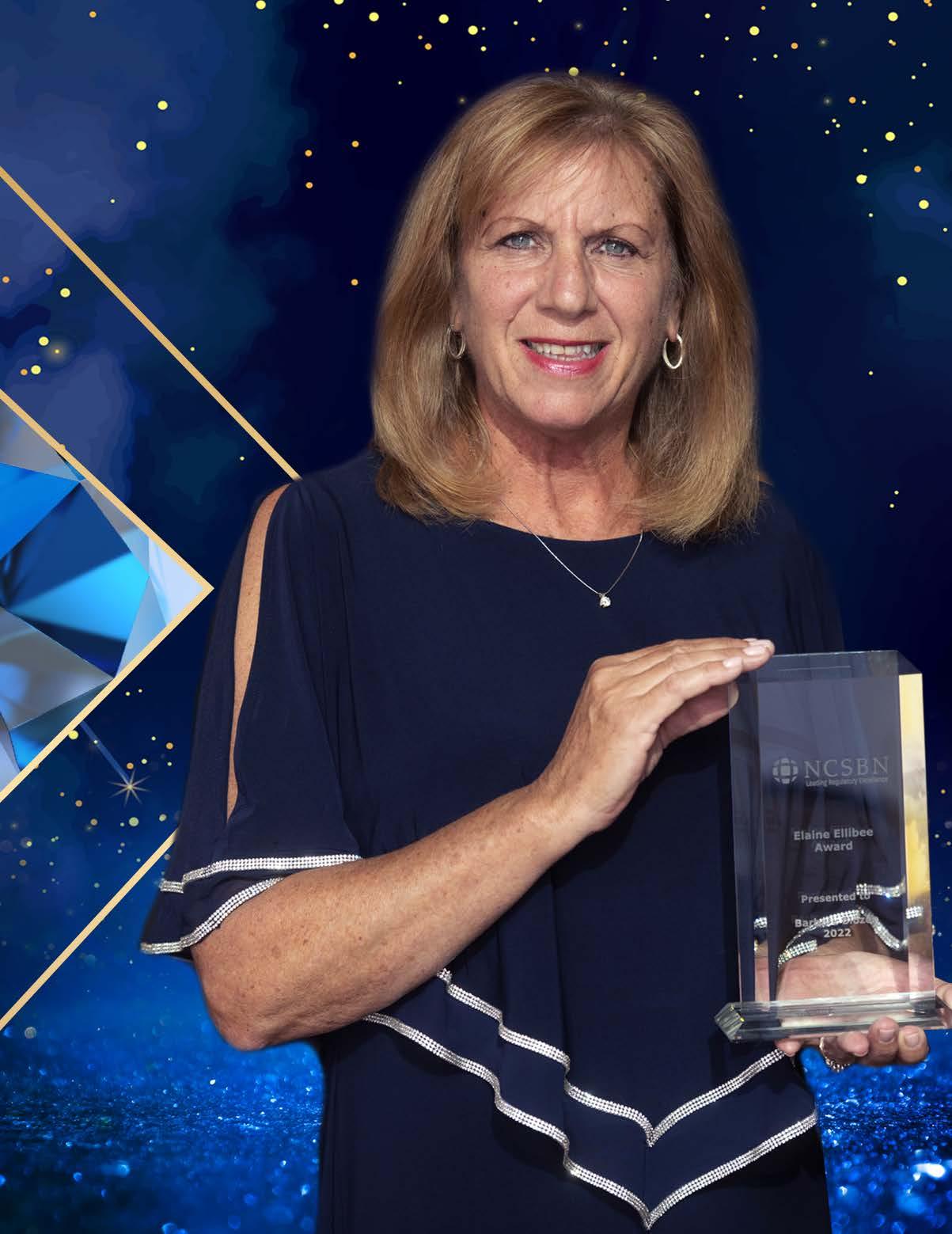Inside this Issue:
Diversity, Equity and Inclusion
Underpin NCSBN’s Mission, Values and Goals

Class is in Session
Dive in and Recognize Someone
2023, Vol. 2
Countdown to Launch…
Managing Editor and Writer
Michael Grossenbacher | mgrossenbacher@ncsbn.org
Contributing Editor and Writer
Dawn Kappel | dkappel@ncsbn.org
Designer
Kalona Owens | kowens@ncsbn.org
Founded March 15, 1978, as an independent not-for-profit organization, NCSBN was initially created to lessen the burdens of state governments and bring together nursing regulatory bodies (NRBs) to act and counsel together on matters of common interest. It has evolved into one of the leading voices of regulation across the world.

NCSBN’s membership is comprised of the NRBs in the 50 states, the District of Columbia, and four U.S. territories — American Samoa, Guam, Northern Mariana Islands and the Virgin Islands. There are five exam user members and 25 associate members that are either NRBs or empowered regulatory authorities from other countries or territories.
Mission: NCSBN empowers and supports nursing regulators in their mandate to protect the public.
The statements and opinions expressed are those of NCSBN and not the individual member state or territorial boards of nursing.
Copyright ©2023 National Council of State Boards of Nursing, Inc. (NCSBN) All rights reserved. This document may not be used, reproduced or disseminated to any third party without written permission from NCSBN.
Address inquiries in writing to NCSBN Permissions, 111 E. Wacker Drive, Suite 2900, Chicago, IL 60601-4277. 312.525.3600 | www.ncsbn.org | infocus@ncsbn.org
8 14
In This Issue
Over the last several years, In Focus has extensively covered the development of the NGN. As the day of launch quickly approaches, NCSBN wants to ensure that candidates, nursing educators and researchers have the appropriate resources at their fingertips to be prepared for this enhanced exam.



2023, Vol. 2 | 3
2023, Vol. 2 Dive In and Recognize Someone ................................ 4 New Jersey Board of Nursing President encourages colleagues to participate in NCSBN Awards Nominations. Diversity, Equity and Inclusion Underpin NCSBN’s Mission,Values and Goals ............................. 8 Pathways to Leadership: The Power of Purpose as Leaders ............................. 12 By:
Nursing Countdown to Launch 14
Joe Baker, Jr., Executive Director, Florida Board of
Class is in Session! ..................................................... 24 An Interview with Cheryl Pulec, EdD, Director of NCSBN’s International Center for Regulatory Scholarship Interstate Compacts for Licensure: Full Speed Ahead! 30 By: James Puente, MS, MJ, CAE, Director, Nurse Licensure Compact Speed Round 27 News & Notes ......................................................... 29 24 4 12
AWARDS

Dive In and Recognize Someone
New Jersey Board of Nursing President Encourages Colleagues to Participate in NCSBN Awards Nominations
Barbara Blozen, EdD, MA, RN-BC, CNL, is president of the New Jersey Board of Nursing (NJBON) and a tenured professor at New Jersey City University where she is responsible for clinical and theoretical instruction, academic advising and supervision. She recalls that in one of the initial RN-to-BSN classes she taught, she tasked her students with recognizing a colleague, acknowledging a fellow nurse.
“Many of the health care agencies provide their staff with opportunities to recognize a colleague,” explains Blozen. “Nurses often are referred to as unsung heroes, and they don’t always take the time to compliment one another. I wanted to turn that around, and I wanted it to be positive. The work we do is difficult at times to articulate, and I don’t think the lay public knows what nurses do. In the beginning of the pandemic the public began to realize what we do, but oftentimes if it’s out of sight, it’s out of mind. I wanted my students to appreciate and recognize their colleagues.”
In 2022, Blozen was recognized by her colleagues when she became a recipient of
the Elaine Ellibee Award at NCSBN’s Annual Meeting. This award is granted to a member who has served as a board president and who has made significant contributions to NCSBN. The Elaine Ellibee Award has only been given to six individuals, and Blozen’s inclusion is a testament to her leadership. Elected by her peers for five consecutive terms as president of the NJBON, Blozen fosters a spirit of inquiry and empowers others while preparing teams for change and innovation. Her passion for regulatory excellence inspires those around her.
During her tenure, the NJBON implemented the Nurse Licensure Compact and Blozen served as an interim NLC Commissioner. She has served as a reviewer for a number of textbooks, Health Resources and Services Administration (HRSA) grants and conference proceedings. She has been recognized twice as a grant recipient for the Robert Wood Johnson New Careers in Nursing, and for the AACN Gold Initiative to expand the Gold Foundation’s White Coat Ceremony, which led to implementing the iconic ritual of
continued on page 6
2023, Vol. 2 | 5
humanism at New Jersey City University. Blozen is widely published and has presented across the country and internationally on a variety of subjects, including transition to practice, nurse licensure, the nurse practice act and mentoring to name a few. In 2020 Blozen earned a Certificate in Health Policy and Media Engagement from The George Washington University School of Nursing via an NCSBN scholarship. She is also a member of the inaugural class of NCSBN’s International Center for Regulatory Scholarship
“It was an honor and a privilege to be selected, and it was also very humbling to be among the exceptional few who have received the Elaine Ellibee Award,” says Blozen. “Elaine Ellibee was a pioneer. She chaired the special task force that led to the founding of NCSBN and served as its first president. She strongly believed in the importance of public protection, superior patient care and continuing education for nursing leaders. Her impactful contribution to nursing education and leadership is noteworthy.”
Blozen takes pride in the work she does leading the New Jersey Board of Nursing, explaining that she and her colleagues have an obligation of public protection for the citizens of New Jersey. “I take the responsibility of a board of nursing president very seriously. Serving on the board and being involved with NCSBN has been an extraordinary experience. NSCBN has afforded me the opportunity to learn, grow, gain wisdom, and to serve in the leading regulatory organization. I’m extremely proud to be an active participant in NCSBN.”
Each year the NCSBN Awards Committee provides NCSBN members with the opportunity to celebrate outstanding achievements in nursing regulation by accepting their nominations for the annual NCSBN Awards Program. More than ever in 2023, as we celebrate NCSBN’s 45th sapphire anniversary, we want to recognize ongoing projects and initiatives that make a difference and can inspire others.
“Everyone needs accolades at one time or another,” says Blozen. “I would tell people to take the plunge, dive in and recognize someone. They will feel appreciated, and the award will validate the work they do. Most board of nursing presidents are volunteers. So, nominating a colleague for the Elaine Ellibee Award would recognize, acknowledge and appreciate the work they do, and the responsibility they have in making regulatory decisions for the citizens of their jurisdiction.”
In addition to nominating others, NCSBN strongly encourage individuals to consider the impact of their own work in support of NCSBN and nominate themselves for award consideration.

“Although I imagine many of us are humble and self-praise is not a characteristic that people want in their resume, it is a good idea to self-nominate as we need to get the word out about what we do,” explains Blozen. “As a student, I remember not knowing much about the board of nursing. I was a bit in awe of them, but I didn’t know the work that the board did. Nominating yourself, articulating what you do, would educate nurses and the public out there about what you do and the role you play in public protection. It will help bring that to the forefront and will validate and put into words and actions what nurses do.”

6 | In Focus
continued from page 5
Barbara Blozen received the Elaine Ellibee Award at the 2022 NCSBN Annual Meeting.
AWARDS
Shine like a sapphire to shape the brilliant future of NCSBN




Someone you know is setting a shining example for others. This is your opportunity to celebrate their outstanding achievements! As we celebrate NCSBN’s 45th sapphire anniversary, we want to recognize ongoing projects and initiatives that make a difference and can inspire others.
Visit the Awards Program webpage (NCSBN member login required) for informative tools and guidance on preparing a compelling awards nomination, and the chance to watch videos of previous awardees.

Nominate Today
Submission Deadline: April 7, 2023
Diversity, Equity and Inclusion Underpin NCSBN’s Mission, Values and Goals
Diversity, equity and inclusion are concepts that are bandied about by governments, corporations and organizations across the world. In some cases, the efforts made by these entities are sincere and significant, while others suit a public relations agenda by paying lip service to what should be substantial changes.
8 | In Focus
NCSBN and its members are firmly committed to diversity, equity and inclusion underpinning its mission, values, and strategic goals and initiatives. In a recent essay published in Taking Action, a new book by Susan B. Hassmiller, PhD, RN, FAAN, and Gaea A. Daniel, PhD, RN, NCSBN CEO David Benton, RGN, PhD, FRCN, FAAN wrote, “It has been recognized that there is a mismatch between the ethnic profile of practitioners and the populations they serve. Despite this recognition, little progress has been made in increasing the diversity of the non-white nursing workforce.”
In Focus interviewed Benton about what NCSBN and its members, the nursing regulatory bodies (NRBs) in the U.S. and across the globe, have done and continue to do to increase diversity, equity and inclusion in the nursing workforce.
“First of all, you need to think about the component parts,” says Benton. “Diversity is about finding the right solutions for the particular problem that you are dealing with at the time. Equity is about justice, making sure that everyone gets the opportunities they need to address challenges they face.
Inclusion is at the heart of improving services and the quality of service. Ultimately, it’s about the public getting the right outcomes.”
Benton notes two examples of turning concepts into a practical reality are the NCLEX® Examinations and the discipline process at the jurisdictional level.
“The NCLEX Examination is critically important to public safety. We need to make sure that every nurse who enters practice meets the same standards of safety and competence at the entry level,” Benton asserts. “We take great care in the development of our items to make sure that they don’t discriminate against anyone. Not just on the basis of color or ethnicity, but also on the basis of gender and other factors. So every single item goes through a process that makes sure that it does not differentiate against individuals on the basis of some of these factors, but really focuses in on making sure that it is a fair, valid test.” (For a detailed explanation of this process see “Out of Many One: Ensuring Integrity, Sensitivity and Rigor in the Development of NCLEX® Items” in the Winter 2021 issue of In Focus).
Another vital component in ensuring diversity, equity and inclusion is the work done by NRBs to make sure the disciplinary process does not discriminate in its decisions.
“The NRBs developed rigorous processes that make certain that if the circumstances surrounding the discipline case are the same, then the result of any action that is taken is equivalent as well,” explains Benton. “It is essential that it doesn’t matter whether you’re male or female, whether you’re Black or white, whether you come from an Asian perspective or not, all of these things should be
continued on page 10
2023, Vol. 2 | 9
completely ignored. There can be no presumption of guilt or innocence on the basis of the person’s name or the color of their skin. What it should be about is what the individual did in relation to that particular incident under disciplinary review.”
The workforces of NCSBN and its members are yet another example of impact in action on these concepts. Benton takes pride in the fact that NCSBN demonstrates these principles in its hiring and workplace environment.
“NCSBN has an extremely diverse workforce. We have African-American colleagues, we have Asian colleagues, we have those with Hispanic heritage, we have individuals who have a history from Europe and from other parts of the world as well. They contribute different perspectives and enrich the organization,” notes Benton. Likewise, NRBs have worked to ensure their workforce reflects the diversity of their own community.
When asked what nursing regulation is doing to bring about greater diversity, equity and inclusion into the profession, Benton says, “One small thing is that we are making sure that when we are promoting nursing we reflect local communities in those images and examples, so that there isn’t

a stereotype that only speaks to a subset of the population. We want to depict that men can be nurses and that people of different ethnic and racial backgrounds can all be nurses; that nurses are and should be more than one gender or ethnic or racial group. It all makes a difference in terms of how you are perceived by the local population.”
Benton cites an example from his past, “I was working in a mental health facility serving the Highlands of Scotland. I recall one day working in an acute psychiatry ward when a family arrived very distressed about what was happening to their daughter. Often when someone comes into an environment where they’re concerned about their relative, they revert to the language that they feel most comfortable with and in this case that language was Gaelic. In that facility, we spoke English and a form of English language called Doric. I don’t speak any Gaelic and none of the staff attending to the patient spoke any of it. I did remember that one of the nurse managers was able to speak Gaelic. I asked them to come down to the ward and speak with the family. From that point forward a very distressed family became a family at ease because they could relate directly to the individual who spoke their language, listened and understood their concerns.”
10 | In Focus
If we make a difference in the work that we do, then that will make a contribution to the solution
“
— David Benton
Benton continues, “Diversity, equity and inclusion are tied to positive patient outcomes. If a patient cannot relate to the nurse that is caring for them, they are less likely to comply with their recommendations or instructions. Seeing someone whom the patient feels comfortable with, who has the same values they have, they are much more comfortable relating to that individual. The patient tends to be more attentive to what the nurse says and can work collaboratively with them as part of their journey to health.”
Some NRBs are working closely with nursing programs to provide a pathway into the nursing profession. They are encouraging people to come into the profession via paths they might not have followed on the traditional route of high school and then college. Benton adds, “We’ve seen individuals who have initially qualified as a licensed practical nurse (LPN) go on to become a registered nurse (RN). But we actually need to think about what is the most diverse group, support workers like certified nursing assistants, and find ways of facilitating their transition into those higher levels of practice. Support workers may not have a traditional educational experience, so finding ways of bridging between support worker to LPN or RN onto advanced practice is a challenge that we need to face as we move forward.”
Benton feels that NCSBN can be a trailblazer in several important areas.
He stresses that having a workforce model that embraces the changing demographics of society in a way that ensures there are sufficient health workers to adequately reflect the population is vital. “To do this, we cannot just plan for certain the number of RNs or LPNs. We need a plan for a number of support workers. As part of our current
strategic initiative cycle of work, we are looking at how we plan a workforce for today and tomorrow; not one for yesterday. This means that we must, first of all, describe that system, describe how the elements join together and will then be deployed in a way that challenges and then builds upon our existing educational models.”
Benton says that an obstacle to be overcome is that individuals often attend school in larger cities and towns and then get jobs in those locations, never returning to their own home communities, which often are those of greatest need. “As part of the Tri-Council, NCSBN is poised to work with its fellow members to collaborate with service providers, with educators and with the political structure to make the changes that we need to have a sustainable workforce that is sufficiently diverse and that will have the skills needed to relate effectively to the population as a whole.”
Benton concludes, “NCSBN cannot solve all of the diversity, equity and inclusion issues. But if we make a difference in the work that we do, then that will make a contribution to the solution. Staying focused on our core business is essential, because if we can get that right, we can have a profound effect on the way that health care is delivered in this country.”
Although Benton has articulated many of the challenges in bringing about more diversity, equity and inclusion to nursing, he notes that there is much excellent work underway, “When I visit boards of nursing and I talk to them about what they are doing, or when I have the chance to observe clinical practice areas, I am impressed by what is going on. We need to take the time to stop, examine and celebrate this work. When we shine a spotlight on and celebrate it, we encourage more of the same.”
2023, Vol. 2 | 11
watch video
“
If I cannot relate to the person that is caring for me, I’m less likely to comply with their recommendations
The Power of Purpose as Leaders
 By Joe Baker, Jr., Executive Director, Florida Board of Nursing
By Joe Baker, Jr., Executive Director, Florida Board of Nursing

Years ago, as a college sophomore and newly elected president of my fraternity, I attended our national conference and heard our CEO give a speech in which he told the parable of the three bricklayers. The story has stuck with me since that day in 1983. It goes something like this:
After the great fire in 1666 that leveled much of London, Christopher Wren, the famous architect, was brought in to rebuild St. Paul’s Cathedral. One day, several years later, he was walking by and observed three bricklayers on a scaffold: one crouched, one was half-standing, and one was standing tall. Mr. Wren asked them, “What are you doing?” The first replied, “I’m a bricklayer. I’m working hard laying bricks to feed my family.” The second bricklayer responded, “I’m a builder. I’m building a wall.” But the third bricklayer, the most productive of the three and a future leader of the group, responded to the same question, answering with a gleam in his eye, “I’m a cathedral builder. I’m building a great cathedral to the Almighty.”
Pathways to Leadership | Members of NCSBN’s Leadership Succession Committee Share their Journey
Baker
This story has always inspired me to focus on what I am doing. It encourages me to ask myself and my colleagues: what are we doing together? How do we view our roles? How do others view what we are doing? How can we do it better? How can I change my perspective on what is being done?
Are we thinking of the big picture or just what is right in front of us to accomplish today? What is our attitude like when it comes to our work? Is it positive or negative, or just ambivalent? Do we think about what we are doing as being aligned with our organization’s mission, vision and values? If not, we need to reflect on our purpose.
It’s difficult sometimes to stay focused, with that gleam in our eyes, on what we are doing and its purpose in the bigger picture of our work setting. But take a pause if necessary. Refocus. Regroup. Talk with a colleague. Take a walk to clear your head. Use some of your well-earned vacation time to truly rest and get away from it all.
Are we just showing up for work to earn a paycheck? Are we just going through the motions of our job without much excitement? Or are we eagerly approaching our job, knowing that what we are doing each day contributes to the greater goals of nursing regulation?
Leaders have a purpose. We influence. We help others to understand that they matter, what they do matters. Together we can make a difference in our world -- not just in our state or jurisdiction, but globally. But we must work together with a common purpose. We need to help each other find our cathedrals to build.

As a nursing regulator, what are you doing? What are we building together? It’s food for thought — today and always.
Take the Lead and Participate in NCSBN
The members of NCSBN’s Leadership Succession Committee endeavor to provide future, emerging and current leaders with an insider’s look into the value of serving in a NCSBN leadership role. NCSBN members can pursue a variety of leadership paths to support their professional development. Getting involved with NCSBN benefits you both personally and professionally. Find out how to apply for a leadership position (member login required).

2023, Vol. 2 | 13
Countdown to Launch…
• More than a decade in development
• 127 item development panels
• 600 plus (and counting!) nurse contributors in item development
• 680,000 NCLEX candidate participants in the Special Research Section
• 143 NGN presentations conducted reaching approximately 22,300 attendees
• Countless hours of research and analysis
An Enhanced Exam for the Real World of Nursing Bringing the Next Generation NCLEX (NGN) to Launch –April 1, 2023
Over the last several years, In Focus has extensively covered the development of the NGN, most recently in 2022, when we interviewed Philip Dickison, PhD, RN, chief operating officer, NCSBN, who reflected on the trajectory of this high-stakes, premier exam. But now as the day of launch quickly approaches, NCSBN wants to ensure that candidates, nursing educators and researchers have the appropriate resources at their fingertips to be prepared for this enhanced exam.

14 | In Focus
VIEW NGN RESOURCES

2023, Vol. 2 | 15
continued from page 15
For Candidates Your one-stop NCLEX® resource nextgennurses.org


You have put in the work, studied hard, attended classes and have had clinical experiences in both simulated and real-world environments – now is the time to demonstrate what you know and exercise your clinical judgment. The NCLEX is your next step. Passing this exam is your pathway to practice as a licensed nurse, and it launches an invaluable nurse into the health care system. Your success may someday mean the difference between life or death for a patient.

NCSBN has prepared resources that will guide you through the process, from applying to a nursing regulatory body, registering for the exam, scheduling, and familiarizing yourself with how the test is administered and the type of questions you will experience. There are many resources available to help you prepare:
NCLEX® Information Flyer


This informational flyer walks you through the process, from applying to a nursing regulatory body, to registering for the exam and scheduling your exam day.
NCLEX® Candidate Bulletin

This resource is a startto-finish NCLEX guide, including important contact information, details on how to register, the NCLEX Candidate Rules and results processing. Be sure to review this bulletin before registering to take the NCLEX.
2023 RN Test Plan and 2023 PN Test Plan
The test plans contain in-depth information regarding exam content, exam administration, item writing tips and the inclusion of clinical judgment. They include information on the following:
• A definition of each Client Needs category
• A definition of clinical judgment

• Nursing activity statements
• Detailed content examples
• Sample NCLEX items
• Item writing tips
16 | In Focus
The Eight Steps of the NCLEX Apply for licensure/registration with one Nursing Regulatory Body (NRB). Register and pay the or by calling Pearson VUE NCLEX Candidate Services at Payment via credit, debit or prepaid card (MasterCard, Visa or American Express). 3. Receive Acknowledgement of Receipt of Registration from Pearson VUE by email. NRB makes you eligible in the Pearson VUE system. You must be made eligible by the NRB within 365 days of your NCLEX registration and payment. 5. Receive Authorization to Test (ATT) email from You must test within the validity dates (an average of 90 days) on the ATT. There are Schedule your exam appointment or by calling Pearson VUE NCLEX Candidate Services at 866.496.2539. 7. Arrive for the exam with your acceptable identification and complete your exam. 8. Receive your official results from your NRB up to six weeks after your exam (this time period varies amongst NRBs). No Refunds There are no refunds of NCLEX fees for any reason. Acceptable Identification Use the exact first and last names that are on your ID when registering for the NCLEX with Pearson VUE. At the test center, the first and last names on the ID you present VUE system. they do not match you will be required to reregister and pay another exam All forms of identification must be valid and meet the following requirements: Government issued Non-expired Name (in Roman characters) Recent photograph Signature Acceptable forms of identification for domestic test Passport books and cards Provincial/territorial or state identification card Permanent residence card Military identification card The only identifications acceptable for international test centers, including Puerto Rico, are: Passport books and cards If your ID does not contain signature but meets all other ID requirements listed above you must bring in secondary form of identification to the test center. The signature on your secondary ID must match exactly with the first and last name on your primary ID and with the names that you provided when you registered. The secondary identification must contain: Signature (in Roman characters) The definitions of domestic and international test centers can be found on the Testing Locations page If you cannot provide an acceptable ID at your appointment, you will have to reregister and pay another The Pathway to Practice
2023 NCLEX® Examination Candidate Bulletin The NCLEX candidate bulletin contains information for all registrations and scheduling of NCLEX appointments beginning April 1, 2023. Additional information is available at www.nclex.com
Candidate Tutorial
This tutorial helps you become familiar with the Pearson VUE exam software that is used during the exam, with the opportunity to practice item functionality available during the exam. Access instructions on how to interact with different item (question) types that you may see during your NCLEX examination. The items included in the tutorial are a representative sample of items that you may see during the exam.


Computer Adaptive Testing (CAT) Video

The NCLEX uses computer adaptive testing (CAT), this video will help you understand how CAT helps the NGN get the most precise measurement in the fewest number of questions.

Sample Pack
Experience the NGN’s new item types with our sample pack. The sample pack includes:
Three RN Case Studies
Two PN Case Studies
Additional examples
2023, Vol. 2 | 17
•
•
•
Page 3/64 ©2021 NCSBN. All rights reserved. Screen 2 of 6 The nurse in the emergency department (ED) is caring for 78-year-old female client. For each client finding below, click to specify if the finding is consistent with the disease process of pneumonia, a urinary tract infection (UTI), or influenza. Each finding may support more than 1 disease proce Client Findings Pneumonia Urinary Tract Influenza confusion body soreness cough and sputum Note: Each column must have at least response option selected. Nurses’ Notes Client was brought to the ED by the client’s adult child due to increased shortness of breath this morning. The adult child reports that the client has been running a fever for the past few days and has started to cough up greenish mucus and to complain of soreness throughout the body. Client was hospitalized for issues with atrial fibrillation 6 days ago. History of hypertension. Vital signs: 101.1° F (38.4° C), P 92, RR 22, BP 152/86, pulse oximetry reading 94% on oxygen at L/min via nasal cannula. On assessment, the client’s breathing appears slightly labored, and coarse crackles (rales) are noted in the bilateral lung bases. Skin slightly cool to touch and pale pink in tone; pulses 3+ and irregular. Capillary refill is 3 seconds. Client is alert and oriented to person, place, and time. The adult child states, “Sometimes seems like my parent is confused.” Peripheral venous access device (VAD) placed in right forearm. FREE DOWNLOAD
For Candidates
Tips for Exam Day
Dress Comfortably
Remember you’ll be required to leave hats, scarves, gloves and coats outside of the testing room (provisions are made for religious/ cultural dress).
Arrive Early
Plan to arrive 30 minutes before your exam. If you are more than 30 minutes late, you may have to forfeit, reregister and pay another exam fee.
Provide Your Biometrics
In order to be tested, the following biometrics will be taken: signature, photograph and palm vein scan.
Set Your Pace
You’ll have up to five hours to complete the RN and PN exams, including two optional breaks (the first two hours into testing, the second after 3.5 hours of testing). Take time to analyze each question carefully—once you submit an answer you cannot return to that question.
Be Aware
You cannot bring in paper or writing instruments for this computer-administered exam. An on-screen calculator and erasable note board/marker for making notes will be provided.
Finishing Up
The test will end with a short survey. Afterwards, candidates should raise their hand and wait for the test administrator to dismiss them.
Keep in mind that although the exam is graded as you progress, scores go through a second verification process at Pearson VUE. Your score is not available and will not be released at the test center.
After the Exam: Unofficial and Official Results
If your nursing regulatory body (NRB) participates in the Quick Results Service (which only applies to candidates seeking licensure in the U.S.), you can receive your “unofficial” results two business days after the exam. This service is available for $7.95 from your candidate profile.

Official results are only available through your NRB and will be sent to you approximately six weeks after the exam. We ask that you do not call NCSBN, Pearson VUE NCLEX Candidate Services or the test center for results.

18 | In Focus continued from page 17
For Nursing Educators
Your charge as a nursing educator might often seem daunting – instructing the next generation of nurses in order for them to practice safely and competently at the entry level. It is your role to help shape the nurses they will become and the NCLEX is just one step in that process. In addition to all of the resources listed under the “For the Candidate” section of this article, we’ve collected a variety of resources that will not only help you familiarize yourself with the NGN, how it is administered and how passing standards were determined, but also how to best prepare your students for exam success.
Passing Standard
A vital component of all credentialing programs, standard setting is an evidence-based methodology for establishing the passing standard (sometimes called “cut score” or “passing score”) associated with an examination. For the NCLEX, the passing standard acts as the dividing line between examinees who have demonstrated the knowledge, skills and abilities required to provide safe and effective care and those who have not. At its core, the NCLEX standard setting answers the critical question of how well examinees must do in order to demonstrate practice readiness.
The NCSBN Board of Directors (BOD) voted on Dec. 6, 2022, to uphold the current passing standards for the NCLEX-RN and NCLEX-PN Examinations when the NGN is launched April 1, 2023.

The BOD used multiple sources of information to guide its evaluation and discussion of the passing standard. As part of this process, NCSBN convened expert panels of nurses representing the four NCSBN geographic areas and Canada. The panels took part in the workshops to perform a criterion-referenced standard-setting procedure and their findings supported retaining the current passing standard.
For a more detailed explanation of the passing standard, read our recent In Focus article, “Practice Ready: Setting the Standard for the Next Generation NCLEX.”
continued on page 20

2023, Vol. 2 | 19
For Nursing Educators
2023 RN Test Plan and 2023 PN Test Plan
Updated every three years to reflect fair, comprehensive, current, entry-level nursing competency measurement, the plans guide candidates in preparing for the exam. The test plans contain in-depth information regarding exam content, exam administration, item writing tips and the inclusion of clinical judgment. The test plans have information on the following:
• A definition of each Client Needs category

• A definition of clinical judgment
NCLEX Program Reports
• Nursing activity statements
• Detailed content examples
• Sample NCLEX items

• Item writing tips
An NCLEX Program Report subscription provides information about first-time graduates testing between April 1 and March 31 of each year, and a comparative review of a program’s performance that is designed to help educators and administrators identify their program’s areas of strength and weakness. Seven different editions of the NCLEX Program Reports are published each year.


2023 NCLEX Conference
Held annually, this one-day educational conference will take place on Sept. 21 this year. It provides nursing educators with NGN updates along with helpful tips and techniques for applying the NCSBN Clinical Judgment Measurement Model (NCJMM) in the classroom. Live question and answer sessions will be available throughout the event. The conference will also feature a variety of video resources about the NCLEX.
20 | In Focus continued from page 19
Leader to Leader
Keep up-to-date on topics of concern to you as a nurse educator with NCSBN’s biannual Leader to Leader newsletter. This publication brings education and regulation together by informing nurse educators of critical issues affecting nursing education and regulation. Leader To Leader covers a variety of topics, including critical thinking, social media, simulation, professional boundaries and transition to practice, to name a few. Experts from across the country in nursing education and regulation serve as contributing authors, providing their insight on current topics that matter most to nurse educators. You can subscribe to receive this free newsletter delivered directly to your inbox.
Become an Item Writer or Item Reviewer
You will give back to the body of nursing knowledge, but you will also reap the benefits of participation:
• Contribute to continued excellence in the nursing profession


• Network on an international level
• Build new skills that are useful at work as well as for professional growth

• Receive verification of continuing education contact hours




Item writers create the items (questions) that are administered on the NCLEX and REx-PN®. You must be responsible for teaching basic/undergraduate students in the clinical area. NCLEX-RN item writers must have a master’s degree or higher.
Item reviewers examine the items that are created by item writers. You must be currently employed in clinical nursing practice and working directly with nurses who have entered nursing practice during the past 12 months, specifically in a precepting or supervising capacity.
2023, Vol. 2 | 21
is Less Than a Year Away! By Jason Schwartz, MS, Director, Outreach, Marketing & Advocacy, NCSBN W hile many educators first heard about the Next Generation NCLEX with or just ahead of the launch of the NCLEX-RN Special Research Section, here at NCSBN began in earnest a full decade ago. The origin of the NGN came at the January 2012 meeting of the NCLEX Examination Committee, a forum in which nurse regulators provide oversight and guidance on current and upcoming matters related to the NCLEX-RN and “Is the NCLEX measuring the right things?” This is question so foundational to any exam that it’s often taken for granted. Furthermore, the triennial Practice Analyses NCSBN conducts were designed specifically to ensure the answer to this very question was always a resounding “Yes!” Nonetheless, Hooper’s Just as a reading language arts teacher with only multiple-choice test would be unable to test essay writing, we recognized there were certainly aspects of entry-level nursing concepts largely untenable through our computerbased testing environment. Principal among these was clinical judgment. We had two choices. One was to explain why comprehensive, valid and direct measurement of clinical judgment was not possible on a large scale, high stakes, computer- based measurement of clinical judgment would require. NCSBN opted for this latter approach, focusing not on the barriers themselves but on how to overcome them. As our measurement and testing experts considered the creative and technological advances needed to assess clinical judgment, we also conducted two studies, literature review and strategic practice analysis, ascertaining the criticality of clinical judgment to competent entry-level continued on page While clinical judgment skills tend to improve over time as nurses become more experienced, an important finding here was that nurse cannot begin at zero. Bringing Nursing Regulation & Education ogether I n the fall of 2020, NCSBN launched the Annual Report Program (ARP) for nursing regulatory bodies (NRBs) in the U.S. For this program, NCSBN collects the nursing education annual report data that most NRBs require. The goals of this new program are twofold. First, NCSBN is assisting the NRBs with this time-consuming data collection. Secondly, NCSBN is then creating the first-ever nursing education database for the nursing community. The ARP team has developed evidence-based core questions that are asked among all the participating NRBs, Besides demographic data, all the questions are based on the quality indicators and warning signs reported in NCSBN Regulatory Guidelines for Pre-licensure submit their own additional questions (AQs). NCSBN then cleans, verifies and analyzes the data for each NRB. The NRBs receive a final report of their state’s data, with asterisks by those programs that don’t fully meet certain evidence-based quality indicators. Armed with the annual report data, the NRBs and programs can work together to identify needed program improvements NCLEX pass rates and that they don’t begin to fall until other key quality indicators have not been met. Map of Participating NRBs IN THIS ISSUE … NCSBN’s Annual Report Program: Report of the Students and Faculty The APRN Compact: Two Years in Legislative Action Q&A: How can apply for an NCSBN Center for Regulatory Excellence (CRE) grant? Program and Journal of Nursing Regulation on Nursing Regulation through NCSBN’s Regulatory … and more NCSBN’s Annual Report Program: Essential Data for Regulators and Educators
For Researchers
Decades of research developed the NCLEX, building it into the world’s premier licensure exam. NGN is the next phase in its evolution. A wealth of information about the exam is publicly accessible to researchers for their review and use in scholarly endeavors.
Funding is available to scholars interested in exploring research that validates the continued use of the NCLEX for initial licensure and supports enhancements to the NCLEX process.

Additionally, a summer internship program for advanced doctoral students in educational measurement or a related field is available.
Exam Statistics & Publications
NCLEX Pass Rates & Fact Sheets

The NCLEX Pass Rate sheets provide current and historic data on performance on the NCLEX-RN and NCLEX-PN examinations for multiple categories of candidates. NCLEX fact sheets provide volume and pass rate data on the NCLEX-PN and NCLEX-RN examinations.
Nurse Licensure & NCLEX Statistics


This annual publication provides nurse licensure activity data for NCSBN’s 59 U.S. member boards as well as NCLEX statistics by country and state.

Practice Analyses
NCSBN performs job (practice) analysis studies every three years. These studies are used as the basis for the development of the NCLEX-RN and NCLEX-PN test plans.
22 | In Focus
21
continued from page
RESEARCH BRIEF Volume 83 May 2022 Report of Findings from the 2021 RN Nursing Knowledge Survey
NCLEX Research Opportunities
NCSBN’s Technical Advisory Committee (TAC) develops a research agenda to directly benefit the NCLEX program. It solicits and reviews research proposals that address research that supports the continued use of the NCLEX for initial licensure and supports enhancements to the NCLEX process. TAC also facilitates the execution of research.
TAC welcomes proposals from:

• Institutions of higher education
• Public and private organizations, institutions and agencies
• Individuals
Affiliation or partnership with a university or nursing school is not required. The TAC does not provide funding for research that is only loosely related to the NCLEX or is primarily about nursing or education issues.

Information about submitting a proposal can be found in the Application Center
Psychometric Internship
This program offers interns a chance to learn all aspects of operational work on an international CAT licensure examination. The interns will also be required to conduct research under the guidance of the NCSBN psychometric staff on topics related to NGN. Interns will gain practical experience working on issues related to the testing profession, CAT, and licensure and certification exams. The interns will work in the NCSBN offices in downtown Chicago. While the application process is concluded for 2023, new opportunities will be available in summer 2024.

See how the new item
fit into the overall exam with our Exam Preview Be Ready April 2023 nextgennurses.org FREE DOWNLOAD Exam Preview
types

Class is in Session!
An

Interview with Cheryl
 Pulec, EdD,
Pulec, EdD,
Director of NCSBN’s International Center for Regulatory Scholarship
NCSBN launched the International Center for Regulatory Scholarship (ICRS) in 2019 with the goal to provide nursing regulators, health policy leaders and other professionals from around the world the opportunity to develop their leadership and job-specific skills. Recently, In Focus sat down with ICRS Director Cheryl Pulec, EdD, to learn more about this offering from NCSBN. Readers can also learn more about Pulec in this issue’s Speed Round.
We notice that ICRS offers three main tracks of coursework: Continuing Education, Foundations of Regulation and a Certificate Program. How would you compare or contrast these different tracks?
ICRS excels at providing current and future participants unique and exciting educational opportunities in programs that are tailored to individual readiness levels and educational needs.
• Continuing Education (CE) courses are available for anyone to participate, but are specifically designed for nurses. CE courses cover a wide range of subjects to help nurses fulfill their continuing education requirements, sharpen skills and advance their careers.
• The Foundations of Regulation courses offer a diverse curriculum and are open for enrollment to professionals around the world. These courses are designed for new staff members who have recently joined a nursing regulatory body, professionals who are interested in serving on boards and committees, and others looking to enhance their regulatory skills and knowledge.
• The Certificate Program is a great resource that offers a more formal, but still flexible way, to develop leadership and job-related skills, while networking with colleagues from around the world. The ICRS Certificate Program is an interactive, online and blended course of study. Courses are offered in eight-week segments and taught by renowned experts who lead discussions, facilitate professional growth and assign projects with real-life applications. After earning six online credits, completing a capstone project, and attending the ICRS Advanced Leadership Institute, graduates of the program are awarded the ICRS certificate.
Can you share any data in terms of how many different courses have been offered or how many people have participated in our courses?
When ICRS was first launched in October of 2019, there were two courses available for potential participants. Over the last three years, ICRS has grown to more than 40 courses within the continued on page 26

2023, Vol. 2 | 25
Pulec
three distinct educational offerings. ICRS has experienced notable growth from a participant perspective as well. The ICRS Certificate Program has grown to 200 participants who have earned approximately 520 certificate course credits, equating to over 10,000 hours of CE credits.
Who is eligible to take an ICRS course? Are these for NCSBN members only, or are they also available to the public?
ICRS courses are open to everyone. There are fees involved to enroll in most courses, but those are waived for NCSBN members.
For our readers who have not yet taken an ICRS course, what should they expect? For example, are all courses virtual? Is there homework?
All ICRS courses are available online. However, pacing and homework depend on the specific track. For example, the Foundations and Continuing Education courses allow learners to move through the content and activities at their own pace, and there is no homework assigned. On the other hand, Certificate Program courses have instructors who facilitate the learning experience over a period of eight weeks. Generally, instructors will establish weekly expectations around coursework and assignments, but the learner has the flexibility to complete these tasks at any time during the week.
Something new and exciting that we hope to see more of in the future are synchronous (i.e., live) virtual discussions. We’ve received positive feedback from both learners and instructors about their experiences being able to connect virtually in real time.
Our understanding is that the slate of courses for Spring 2023 are already at capacity. Can you provide our readers with any advance information on the Summer 2023 session?

Yes. Our summer term will run from July 10 through Sept. 1, 2023, with registration expected to open the second week of May. Readers who subscribe to ICRS updates will receive an email notification when registration opens. As classes do fill up quickly, I recommend registering promptly.
We’ve covered ICRS from the perspective of the learner, but our understanding is that ICRS is always on the lookout for potential instructors whose expertise might expand our slate of offerings. What information about this can you share with our readers?
Absolutely, we are always open to hearing proposals for new courses. The best way to start the process is to send me an email expressing interest. From there I can work with prospective instructors on their course proposals.
Once course proposals are approved, new instructors meet with members of the ICRS team who will guide them through each phase of the course development lifecycle. Even once the course is launched, the ICRS team continues to provide outreach and support to both instructors and learners. We approach the course lifecycle, from design to delivery, as a team, ensuring a rewarding teaching and learning experience for instructors and students.
Do you have additional questions about ICRS, or suggestions on courses you would like to see in the future? Contact the ICRS team at ICRS@ncsbn.org.
26 | In Focus
continued from page 25
Speed Round
Get to know NCSBN staff:
Cheryl Pulec, EdD Director, International
Center for Regulatory Scholarship



What do you do at NCSBN?
I am the director of the International Center for Regulatory Scholarship (ICRS), working with a talented team responsible for bringing various eLearning program opportunities to life. I’m new to the director role, but I hope to use my experience in program evaluation, curriculum development, and best practice instruction to elevate and expand an already impressive educational program.

What are the best and most challenging aspects of your job?




I really enjoy evaluating programs to identify challenges or gaps and then working with others to develop solutions. Working in the world of eLearning means constantly reflecting on our programs and practices, to ensure we are not falling behind related to new technologies or instructional approaches. At the same time, great educational programming is not solely defined by the most novel approach or shiniest technology. The fun (at least for me) is the challenge of finding balance between substance over style/form and knowing that the decisions we make translate to meaningful educational experiences for our participants.
If you weren’t working at NCSBN, what would your dream job be?
I love everything related to traveling -- learning the history, sightseeing, meeting people, eating all the food -- so some combination of travel planner and guide would be the dream. Basically, I’d want to be Rick Steves or Anthony Bourdain.
ICRS SUMMER 2023 CATALOG
Making
Data Analysis Easy
Introduction to Public Policy
Program and Policy Evaluation
Impact of Federalist Government on State Boards of Nursing
Experts in Humanity: The History of Nursing Regulation
Presentations and Public Speaking
Foundations of Regulation
Dive into the world of regulation with courses designed for professionals looking to enhance their regulatory skills and knowledge. Perfect for new staff members or those interested in serving on boards and committees. Each self-paced course can be completed in one day and all offer continuing education (CE) credits.


Certificate Program

Take the next step in regulation with this competency-based program, offering courses to enhance leadership and governance skills. This online and blended curriculum is designed to cultivate and elevate leaders of state, national and international regulatory bodies. This two-year program provides specialized education on topics unique to health care regulation along three pathways: Governance & Leadership, Public Policy & Legislation, Research & Measurement
Advanced Leadership Institute
At the culmination of the ICRS certificate program, participants graduate at the Advanced Leadership Institute, an exclusive, invitation-only event that will take them to the next level in their journey as a leader in regulation. They will learn from prominent leaders and network with other regulatory professionals from around the world.



Explore the courses at icrsncsbn.org
News & Notes
Ohio Board Ensures Smooth Transition to NLC

On Jan. 1, the Ohio Board of Nursing (OBN) implemented the Nurse Licensure Compact (NLC), making Ohio the 39th state to join the compact. In preparation, OBN undertook several tasks to ensure the transition to multistate licensure would be as seamless as possible for Ohio RNs and LPNs. OBN developed and updated eLicense applications to include NLC-specific wording and processes, and updated all compliance questions for RN and LPN applications. OBN partnered with a marketing vendor to develop outreach and education materials for key audiences to ensure all were aware of the benefits and requirements associated with NLC implementation and multistate licensure. OBN staff traveled throughout the state to share a “Caring Beyond State Boundaries with the Nurse Licensure Compact” presentation. Between July and December 2022, OBN presented to more than 100 prelicensure education programs, more than 40 hospitals and health care providers, and more than 30 professional associations and committees. OBN also attended several high school and college career fairs to share information about the NLC and the nursing profession. As of Feb. 16, OBN has received 9,224 multistate license conversion applications and has issued close to 5,500 multistate licenses.
Zickafoose Honored with Award for Excellence
Pamela Zickafoose, EdD, MSN, RN, NE-BC, CNE, FRE, executive director, Delaware Board of Nursing, has been awarded the American Association of Nurse Practitioners (AANP) State Award for Excellence (Advocate) for her leading role in achieving full practice authority for advanced practice registered nurses (APRNs). This is the second time Zickafoose has received this award. Per the Delaware Nurses Association, “Dr. Zickafoose is a partner and champion of the Delaware Nurses Association. Her role as Executive Director of the Delaware Board of Nursing positions her to lead regulatory, educational, quality and safety efforts on behalf of all Delawareans and the nurses who serve them.”

News & Notes highlights NCSBN member achievements and updates as well as individual leadership and staff accomplishments.


Have news to share? Send your News & Notes submissions via email
Pictured (L-R): NLC Consultant Fred Knight, Ohio Board of Nursing Executive Director Marlene Anielski, and NLC Commissioner Pamela Zickafoose.
2023, Vol. 2 | 29
Staff at all levels at the Ohio Board of Nursing participated in the NLC outreach and education campaign.
Interstate Compacts for Licensure: Full Speed Ahead!
By James Puente, MS, MJ, CAE, Director, Nurse Licensure Compact

Times have changed. In 1999, when the first bills for the Nurse Licensure Compact (NLC) were introduced, such legislation was novel. So novel that legislators were wary of it and had countless questions. Before this point, state legislatures had not seen an interstate compact for the licensure of a health care profession.
Fast forward to 2023. The NLC is not alone as the sole interstate compact for a licensed health care profession. Today, there are nine active compacts in this area. “Compacts” is more of a household name in state legislatures today. Legislators tend to understand the nature of an interstate compact as a contract between states of a statutory nature, the language of which cannot be substantively changed in the legislative process. Since it operates like a contract, for a compact to be valid and enforceable, the bill language needs to be essentially the same in each state which enacts the legislation. That notion seems to be catching on among state legislatures.
The past decade has seen several key phenomena which have enabled licensure compacts to flourish:

• Occupational Licensure Reform: a concerted movement to streamline licensure processes, an effort to eliminate barriers to licensure (especially pertaining to individuals with criminal histories) and revisions to long held paradigms which dictate which professions actually need to be licensed;
• The COVID-19 pandemic; and
• National shortages of health care providers among a variety of professions (many of these shortages existed prior to the pandemic).
30 | In Focus
Puente
Licensure compacts, especially those which embrace the mutual recognition model, enable a health care provider to engage in cross-border practice seamlessly, without delay and without having to jump through any regulatory hoops. Such a notion represents a modernization of licensure which has contributed to a realization that, with uniform licensure requirements among states and national exams, there is no reason a practitioner should not be able to practice in any state, as long as public protection measures are in place. The statutory provisions of a licensure compact are in fact, just that straightforward.

Realizing that interstate compacts are the way to enable practice across state lines without impediments and, therefore, to increase access to care for patients, the U.S. Dept of Defense (DoD) has been instrumental in the development of many of the new compacts that exist today. The DoD has done this through the funding of compact creation along with the implementation of strong advocacy plans. While license portability helps military service persons and spouses, there are many other beneficiaries. Such portability enables the mobility of licensees, which is a vital piece of serving our existing population with a finite number of practitioners.
It is unprecedented that in the first six weeks of the 2023 legislative session, we see 109 pieces of legislation (as of March 2, 2023) aimed at entering additional states into the nine licensure compacts which exist today. Compacts will flourish because they are a powerful public policy tool. In the next two years, we can anticipate many more compacts to be developed and enacted.

SHINE THROUGH SHAPING A BRILLIANT FUTURE 45 2023 MIDYEAR MEETING MARCH 28-30, 2023 | SEATTLE SAVE THE DATE 2023 ANNUAL MEETING AUG. 16–18, 2023 | CHICAGO SHINE THROUGH SHAPING A BRILLIANT FUTURE 45 2023 MIDYEAR MEETING MARCH 28-30, 2023 | SEATTLE















 By Joe Baker, Jr., Executive Director, Florida Board of Nursing
By Joe Baker, Jr., Executive Director, Florida Board of Nursing







































 Pulec, EdD,
Pulec, EdD,























